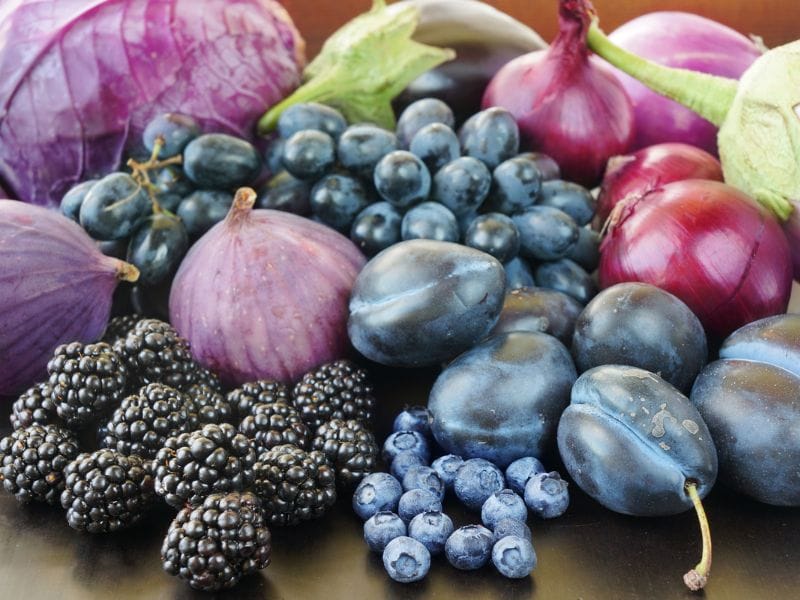
In the realm of nutrition and culinary creativity, there’s a fascinating category of produce that not only adds a burst of color to your plate but also packs a punch of health benefits. We’re talking about none other than “blue and purple fruits and vegetables.” In this article, we’ll take a deep dive into this colorful world, exploring the nutritional wonders, delicious recipes, and the incredible potential they offer for a healthier lifestyle.
Blue-Purple Plant Foods & Anthocyanins
Blue and purple plant foods boast an abundance of antioxidants, particularly those with a remarkable capacity to shield the brain and nervous system against oxidative stress and inflammation triggered by the harm caused by free radicals. Within these plant foods, you’ll find a class of water-soluble polyphenolic compounds known as “anthocyanins” responsible for the vibrant deep blue and purple pigments.
Anthocyanins exhibit rapid absorption and possess the unique ability to traverse the blood-brain barrier, allowing them to exert their advantageous effects directly on brain cells. Although the bioavailability of anthocyanins is relatively low, they manage to find their way to the brain where they can accumulate and have a substantial impact. Additionally, the metabolites generated by anthocyanins yield a plethora of biological benefits, including acting as potent antioxidants, reducing inflammation, and providing neurological protection.

Blue and Purple Fruits and Vegetables: Nature’s Bounty
Let’s begin our journey by understanding the natural treasures that fall under the category of blue and purple fruits and vegetables. These vibrant offerings from Mother Nature include:
Blueberries
Blueberries, often referred to as “nature’s candy,” are a beloved addition to numerous dishes. They are bursting with antioxidants, particularly anthocyanins, which contribute to their rich color and provide a wide range of health benefits.
Blackberries
Blackberries are not only juicy and delicious but also low in calories and high in fiber. They are known to support heart health and digestion while delighting our taste buds.
Purple Grapes
Purple grapes are not just the star of the vineyard; they are also a great source of resveratrol, which is believed to have various health benefits, including potential protection against heart disease.
Eggplant
Eggplant, with its deep purple hue, is a versatile vegetable that can be grilled, roasted, or sautéed to create delectable dishes. It’s rich in fiber, vitamins, and minerals.
Purple Potatoes
Purple potatoes are not only visually appealing but also a nutritious choice. They contain antioxidants and may aid in reducing inflammation.
Red Cabbage
Red cabbage, often showing off its purplish hue, is a cruciferous vegetable that is a great source of vitamins and minerals. It’s a versatile ingredient in salads and coleslaws.
Blue Potatoes
Blue potatoes add a unique twist to your potato dishes. They contain antioxidants and are a fun addition to your culinary repertoire.
Plums
Plums are a delicious and nutritious snack. They are rich in vitamin C, fiber, and antioxidants, making them a fantastic choice for overall well-being.
Health Benefits of Blue and Purple Fruits and Vegetables
The stunning colors of these fruits and vegetables are not just for show; they signify the presence of powerful antioxidants and phytochemicals that offer a myriad of health benefits.
Antioxidant Properties
Anthocyanins are potent antioxidants that help combat harmful free radicals in the body. This antioxidant activity may contribute to reduced oxidative stress and lower the risk of chronic diseases.
Heart Health
Consumption of anthocyanin-rich foods has been associated with improved cardiovascular health. It may help lower blood pressure, reduce cholesterol levels, and promote overall heart function.
Anti-Inflammatory Effects
Anthocyanins have anti-inflammatory properties that may help alleviate inflammation in the body. This can be particularly beneficial for conditions associated with chronic inflammation.
Cognitive Function
Some studies suggest that anthocyanins may support cognitive function and protect against age-related cognitive decline. They may help maintain brain health and memory.
Eye Health
The antioxidants in anthocyanin-rich foods may benefit eye health by reducing the risk of age-related eye conditions, such as macular degeneration and cataracts.
Improved Digestion
Anthocyanins can contribute to better digestion due to their fiber content. They promote healthy bowel movements and support a balanced gut microbiome.
Potential Cancer Prevention
While more research is needed, some studies indicate that anthocyanins may have anticancer properties and could play a role in cancer prevention.

Cooking with Blue and Purple Fruits and Vegetables
Incorporating blue and purple fruits and vegetables into your meals is not only beneficial but also a delightful culinary adventure. Here are some creative ways to use them in your kitchen:
Blueberry Bliss Smoothie: Start your day with a refreshing blueberry smoothie. Blend blueberries with yogurt, banana, and a splash of honey for a nutritious and delicious treat.
Roasted Eggplant Parmesan: Create a classic eggplant Parmesan by layering slices of roasted eggplant with marinara sauce and mozzarella cheese. Bake until golden and bubbling for a mouthwatering dish.
Purple Potato Salad: Upgrade your potato salad by using purple potatoes. Boil them until tender, then mix with a tangy vinaigrette, diced red onions, and fresh herbs for a colorful twist on a classic side dish.
Blackberry Salad: Toss fresh blackberries into your green salad for a burst of flavor and antioxidants. Top it off with a light balsamic vinaigrette.
FAQs:
Are blue and purple fruits and vegetables genetically modified?
No, they are not genetically modified. Their vibrant colors are a result of natural compounds.
Can I freeze blueberries and blackberries?
Yes, you can freeze them for long-term storage. Spread them on a baking sheet to freeze individually before transferring them to a bag or container.
Are purple potatoes safe to eat?
Yes, purple potatoes are safe to eat and are nutritionally similar to other potato varieties.
How can I add more purple produce to my diet?
You can add them to smoothies, salads, soups, or simply enjoy them as snacks.
Do blue and purple fruits and vegetables taste different from their counterparts?
They may have slight flavor variations, but they are generally similar in taste to their more common counterparts.
Can I use purple cabbage in coleslaw?
Absolutely! Purple cabbage adds a vibrant color and a slightly different flavor to coleslaw.
Which of the following phytochemicals gives some fruits and vegetables its deep blue-purple color?
The phytochemical responsible for giving some fruits and vegetables their deep blue-purple color is called “anthocyanin.”
The Take Home on Blue/Purple Fruits and Vegetables
Incorporating blue and purple fruits and vegetables into your diet can be a delightful and nutritious experience. From the rich antioxidants to the incredible culinary versatility, these colorful treasures from nature have so much to offer. So, why not embark on a journey of flavor and health by adding more blue and purple produce to your plate?
DISCLAIMER: Flawsome and Fifty website does not provide medical advice
The information, including but not limited to, text, graphics, images, and other content contained on this website is for informational purposes only. No material on this site is intended to be a substitute for professional medical advice, diagnosis, or treatment. Always seek the advice of your doctor with any questions you may have regarding a medical condition or treatment before undertaking a new healthcare routine or product, and never disregard professional medical advice or delay in seeking it because of something you have read on this website.

